Seminar Review
In the fourth week of the course on the ethics of artistic research, we explored cases about some of the literature, for example, in the reference video that I made in preparation for the class, a question kept circling my mind: does artistic creation actually need to be bound by social ethics? Or what kind of social morality needs to be used to constrain it? Because ideology and morality evolve with society.
https://media.ed.ac.uk/media/1_lufxbzjc
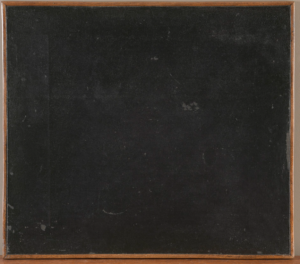
The 1915 work by kazimir Malevich, Black Square, was discovered in 2015 by the art historians of the Tretyakov Gallery, who found a message faintly written in pencil on the white paint in the lower left-hand corner of the composition. The first part of the phrase appears to be “The Battle of the Blacks
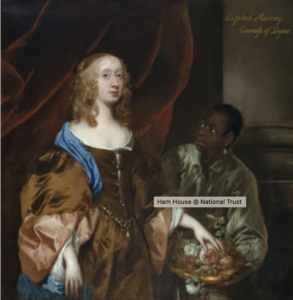
Oil painting on canvas, Elizabeth Murray, Lady Tollemache, later Countess of Dysart and Duchess of Lauderdale (1626–1698) and an Attendant by Sir Peter Lely (Soest 1618 – London 1680), circa 1651.
The position and identity of the black squire in Riley’s portrait are unclear. He does not have a uniform, which is a telltale indicator of domestic servitude, nor does he have a metal slave collar, which is a visual evidence of slavery. The squire continues to be anchored in traditional portrait subjects, such as the aristocratic white female nanny and the companion subject of the enslaved black man, despite the absence of these outward indicators of slavery. The waiter’s crouching stance, the motions he makes, the threshold condition in which he emerges from behind the curtain, and his steely glare at the designated nanny are all examples of this norm, which may be seen in many other portraits from the 16th and 17th centuries.
All of the above are famous artists and painters, so is it not important to discuss whether his moral dimension is right or wrong if the moral rightness or wrongness is only influenced by the difference in chronology?
I don’t think we can use the issue of chronology to avoid moral right and wrong, rather we as art creators we need to deeply understand and study the morality between disciplines, and this is where ethnographic research exists in the field of art.

Trinh T. Minh-ha, Forgetting Vietnam, 2015–16, digital film still. Courtesy: © the artist and Moongift films
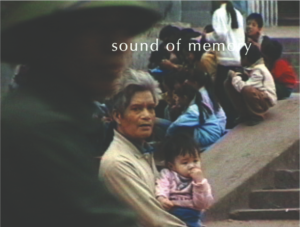
Trinh T. Minh-ha, Forgetting Vietnam, 2015-16, digital film still. Courtesy: © the artist and Moongift films
https://www.frieze.com/article/there-no-such-thing-documentary-interview-trinh-t-minh-ha
The authenticity of documentary filmmakers
The difference between colonial and non-colonial Vietnam is that the so-called nation is not innate, but an acquired environment.
Feminist and environmentalist ecological links: in Vietnamese popular language and songs, as well as in legends and myths, the rower is in most cases a woman. It is very much about the water (or Nuócthe name, which also means ‘country’ in Vietnamese) and the ‘waterways’ associated with the forces of nature as they define Vietnam, her people and her culture.
In order to better allow artists and researchers to produce more in-depth and dialectical works in the modern day, participatory art research is crucial. Equal opportunity and diversity in terms of culture, race, gender, sexual orientation, and other variables must be considered in participatory art research. Researchers must respect the various participants’ cultures and values in order to prevent disputes and prejudice between them.
In addition to the historical ethical issues, artists must also consider themselves in terms of ethical standards when communicating across sectors and participating in various industries.
Often, artists wanting to highlight issues of a social nature will involve some privacy and personal information of the participants, which is strictly speaking a low-level exploitation of people, although through these activities some of their essence can be stimulated. I do not see the art world as an umbrella under which artists have the privilege to reveal traumas and hidden experiences. So the important ethical issue in participatory art research is about informed consent and privacy protection for participants. As participatory arts research often involves personal information and physical contact, there is a need to ensure that participants are fully informed and participate voluntarily. In addition, researchers need to protect the privacy of participants and ensure that their personal information and bodies are not misused or exposed.
Project proposal workshop
Although I knew that creating a project needed to be based on the premise of having a clear project proposal, the fact that I was not quite sure of the direction I should follow as a curatorial project proposal, especially in an art curatorial project proposal about ethnographic anthropology, this course inspired me to have a clearer structural perception of the focus of art curation.
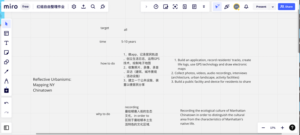
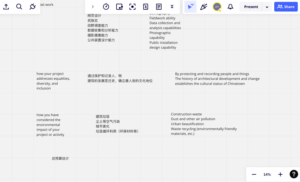
In class we practiced a proposal for the establishment of a cultural community in Chinatown, USA and I learned some relevant theories about consumer targeting, skill needs, target needs and environmental needs.
It was very inspiring for me how my project could contribute to my development or the development of others, this plan needs to be submitted not only to the sponsors but also to the artist, think it through and give a purpose that I think will increase the success of the project, for example: I want to do a project about environmental pollution and conservation (by collecting plankton from polluted water bodies, or some non-biodegradable plastic etc. to collect. or non-biodegradable plastics etc. and transforming these materials into new products), which would increase the development of environmental protection and at the same time generate some economic benefits for the artist. I think this idea would be very helpful for my graduation project and it could have a social and economic impact for the artist and the sponsors.
A long time ago I was involved in an economic and cultural project in rural China (we built a museum, a cultural tourism community in the area) and although the economic results were good, in retrospect we were more like colonists or missionaries. I didn’t explore the local cultural diversity as much as I did the introduction of foreign cultures. I hope to reflect on this and make a note of it in my final assignment.

